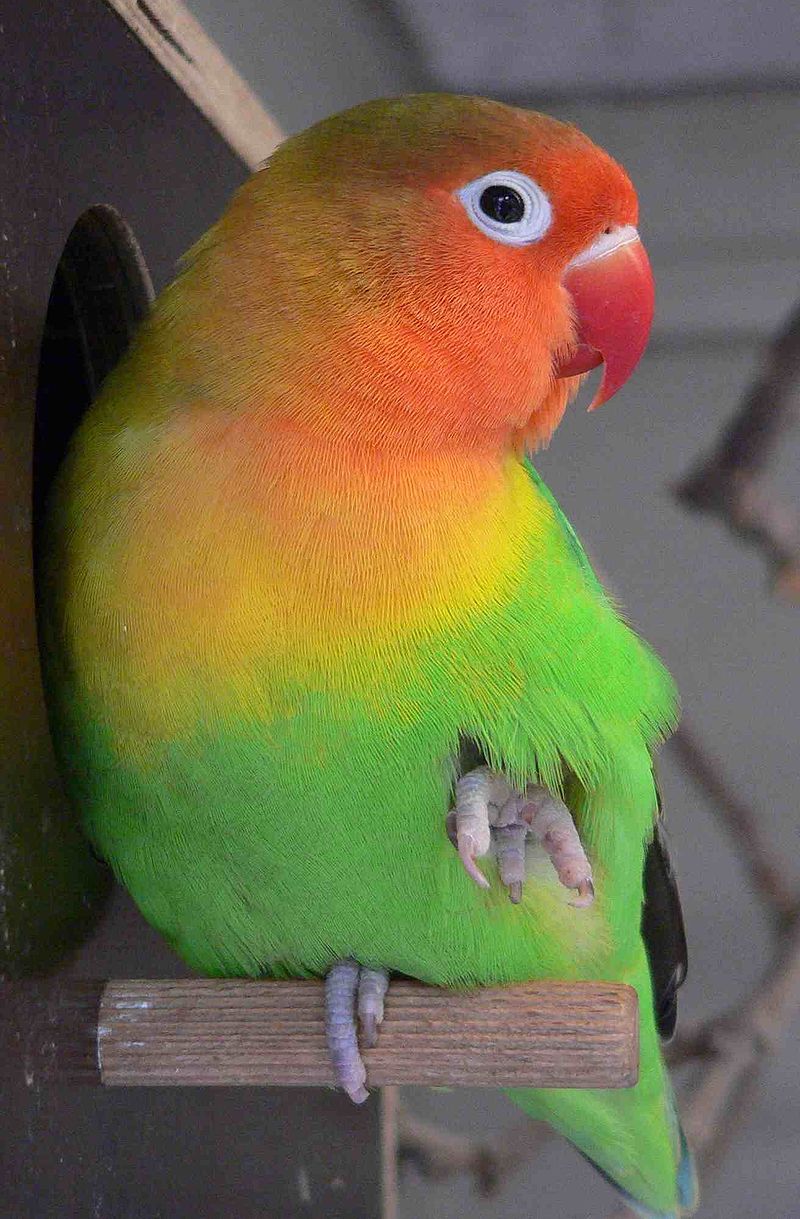
A lovebird is one of nine species of the genus Agapornis (Greek: αγάπη agape 'love'; όρνις ornis 'bird'). They are a social and affectionate small parrot. Eight species are native to the African continent, and the grey-headed lovebird is native to Madagascar. Their name stems from the parrots' strong, monogamous pair bonding and the long periods which paired birds spend sitting together. Lovebirds live in small flocks and eat fruit, vegetables, grasses and seed. Black-winged lovebirds also eat insects and figs, and the black-collared lovebirds have a special dietary requirement for native figs, making them problematic to keep in captivity.
Some species are kept as pets, and several color mutations were selectively bred in aviculture. Their average lifespan is 10 to 15 years.[1]
Bio
Lovebirds are 13 to 17 centimeters in length and 40 to 60 grams in weight. They are among the smallest parrots, characterized by a stocky build, a short blunt tail, and a relatively large, sharp beak. Wildtype lovebirds are mostly green with a variety of colors on their upper body, depending on the species. The Fischer's lovebird, black-cheeked lovebird, and the masked lovebird have a prominent white ring around their eyes. Many color mutant varieties have been produced by selective breeding of the species that are popular in aviculture.
Taxonomy
Phylogeny of the genus Agapornis based on molecular evidence. The species with the red line is currently unplaced in the phylogeny, but does belong to this genus.
The lovebird genus comprises nine species of which five are monotypic and four are divided into subspecies. Eight of them are native in the mainland of Africa and the Madagascar lovebird is native to Madagascar. In the wild the different species are separated geographically.

Traditionally, lovebirds are divided into three groups:
the sexually dimorphic species: Madagascar, Abyssinian, and red-headed lovebird
the intermediate species: peach-faced lovebird
the white-eye-ringed species: masked, Fischer's, Lilian's, and black-cheeked lovebirds
However, this division is not fully supported by phylogenetic studies, as the species of the dimorphic group are not grouped together in a single clade.
Species and subspecies:
Rosy-faced lovebird, Agapornis roseicollis, (Vieillot, 1818)—or peach-faced lovebird
Agapornis roseicollis catumbella, B.P. Hall, 1952
Agapornis roseicollis roseicollis, (Vieillot 1818)
Yellow-collared lovebird, Agapornis personatus, Reichenow, 1887—or masked lovebird
Fischer's lovebird, Agapornis fischeri, Reichenow, 1887
Lilian's lovebird, Agapornis lilianae, Shelley, 1894—or Nyasa lovebird
Black-cheeked lovebird, Agapornis nigrigenis, W.L. Sclater, 1906
Grey-headed lovebird, Agapornis canus, (Gmelin, 1788)—or Madagascar lovebird
Agapornis canus ablectaneus, Bangs, 1918
Agapornis canus canus, (Gmelin, 1788)
Black-winged lovebird, Agapornis taranta, (Stanley, 1814)—or Abyssinian lovebird
Red-headed lovebird, Agapornis pullarius, (Linnaeus, 1758)—or red-faced lovebird
Agapornis pullarius pullarius, (Linnaeus, 1758)
Agapornis pullarius ugandae, Neumann, 1908
Black-collared lovebird, Agapornis swindernianus, (Kuhl, 1820)—or Swindern's lovebird
Agapornis swindernianus emini, Neumann, 1908
Agapornis swindernianus swindernianus, (Kuhl, 1820)
Agapornis swindernianus zenkeri, Reichenow, 1895
Lovebird Nesting and Breeding
Depending on the species of lovebird, the female will carry nesting material into the nest in various ways. The peach-faced lovebird tucks nesting material in the feathers of its rump,[5] while the masked lovebird carries nesting material back in its beak. Once the lovebirds start constructing their nest, mating will follow. During this time, the lovebirds will mate repeatedly. Eggs follow 3–5 days later. The female will spend hours inside her nesting box before eggs are laid. Once the first egg is laid, a new egg will follow every other day until the clutch is complete, typically at four to six eggs. Even without a nest or a male, lovebirds sometimes produce eggs.
Lovebirds Diet
A fresh mix (with or without dehydrated fruits and/or vegetables) of excellent quality combining various seeds, grains and nuts generally represent the typical basic diet. Ideally the basic mix will contain or will be supplemented with an about 30% portion of any bio/organic (naturally coloured and flavoured and without any conservative agent) and/or of any natural (naturally coloured, flavoured and preserved) pellets.
Ideal basic dry mix:
Home made:
- 40% Yellow millet - 18% Canary seed - 10% White millet - 9% Peeled oats - 5% Japanese millet - 4% Safflower - 4% Buckwheat - 3% Paddy rice - 3% Oats - 2% Linseed - 2% Hempseed
Cooked and fresh foods:
These foods and goods must be offered as often as possible (particularly cereals, fruits, greens/weeds, legumes/pulses and vegetables), ideally on a daily basis or at least weekly. The pellet ratio should be increased to 1/2 of the basic dry mix when cooked and/or fresh foods are occasionally or rarely offered.
Whole grains and cereals:
Amaranth, barley, couscous, flax, oat, rice varieties such as basmati, brown rice, jasmine rice, quinoa, wheat, lightly toasted whole-grain Waffles, non-toasted whole grain breads (i.e. corn-bread, multi-cereal, 14 cereals, whole-wheat), al-dente cooked pastas.
Edible blossoms and flowers:
carnations, chamomille, chives, dandelion, day lilies, eucalyptus, fruit trees' blossoms, herbs' blossoms, hibiscus, honeysuckle, impatiens, lilac, nasturiums, pansies, passion flower (passifloræ), rosees, sunflowers, tulips, violets.
Fruits with all discarded pits and/or larger seeds:
All are healthy and can be offered i.e. all apple varieties, banana, all berries varieties, all citrus varieties, grapes, kiwi, mango, melons, nectarine, papaya, peach, all pear varieties, plum, starfruit.
Vegetables:
All are healthy and can be offered including squashes and their freshly harvested and/or oven-roasted seeds. i.e. beet, broccoli, cauliflower, carrots, cucumber, all cabbage varieties, fresh beans, fresh peas, parsnip, all pepper varieties, all squash varieties, sweet potatoes, turnip, yams, zucchini.
